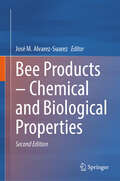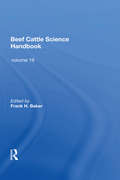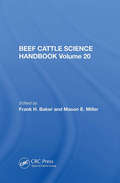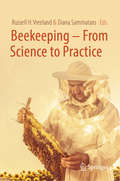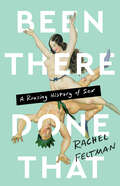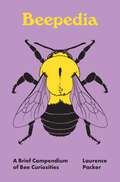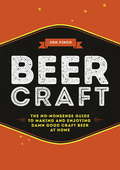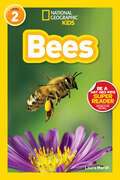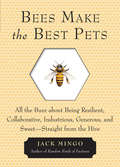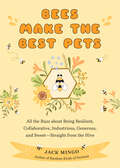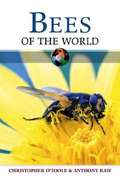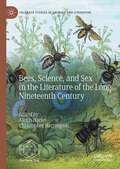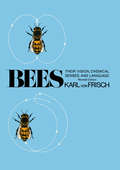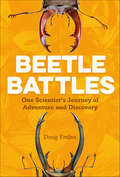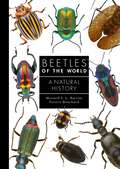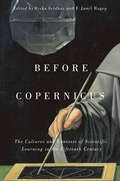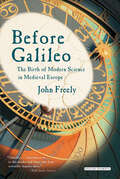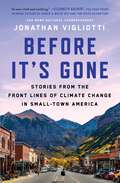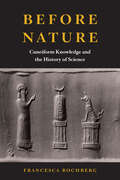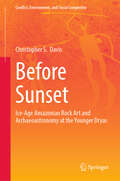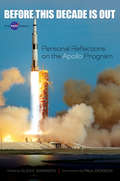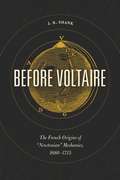- Table View
- List View
Bee Products – Chemical and Biological Properties
by José M. Alvarez-SuarezThis fully updated and extended second edition provides a comprehensive overview of the most important products by Apis mellifera bees. The book provides an easy-to-read introduction to honey classification, sensory and pollen analysis, and a complete compendium of the chemical composition of the main bee products honey, propolis, royal jelly, pollen and bee venom. In addition, this new edition includes two brand new sections on bee bread and wax. The beneficial medicinal and nutritional aspects of these products in aging and age-related diseases, cancer, neurodegenerative diseases and infections are discussed in detail and the methods used to analyse and characterise the individual bioactive compounds are reviewed. The book is a must for researchers in the field of biochemistry of natural products, students and professional beekeepers interested in the chemical diversity of compounds derived from bee products.
Bee Time: Lessons from the Hive
by Mark L. WinstonBeing among bees is a full-body experience, Mark Winston writes. Bee Time presents his reflections on three decades spent studying these remarkable creatures, and on the lessons they can teach about how humans might better interact with one another and the natural world, from the boardroom to urban design to agricultural ecosystems.
Beef Cattle Science Handbook, Vol. 19
by Frank H. BakerThe 1983 International Stockinen's School Handbooks include more than 200 technical papers presented at this year's Stockmen's School-sponsored by Wlnrock International-by outstanding animal scientists, agribusiness leaders, and livestock producers expert in animal technology, animal management, and general fields relevant to animal agriculture. The Handbooks represent advanced technology in a problem-oriented form readily accessible to livestock producers, operators of family farms, managers of agri-buslnesses, scholars, and students of animal agriculture. The Beef Cattle Science Handbook, the Dairy Science Handbook, the Sheep and Goat Handbook, and the Stud Managers' Handbook each include papers on such general topics as genetics and selection; general anatomy and physiology; reproduction; behavior and animal welfare; feeds and nutrition; pastures, ranges, and forests; health, diseases, and parasites; buildings, equipment, and environment; animal management; marketing and economics (including product processing, when relevant}; farm and ranch business management and economics; computer use in animal enterprises; and production systems. The four Handbooks also contain papers specifically related to the type of animal considered
Beef Cattle Science Handbook, Vol. 20
by Frank H. BakerThe 1984 International Stockmen's School Handbooks include more than 200 technical papers presented at this year's Stockmen's School, sponsored by Winrock International. The authors of these papers are outstanding animal scientists, agribusiness leaders, and livestock producers who are expert in animal technology, animal management, and gene
Beekeeping – From Science to Practice
by Diana Sammataro Russell H. VreelandThis book will help beekeepers understand the fundamentals of beekeeping science. Written in plain and accessible language by actual researchers, it should be part of every beekeeper's library. The respective chapters not only present raw data; they also explain how to read and understand the most common figures. With topics ranging from honeybee nutrition to strains of Varroa resistant bees, from the effects of pesticide chemicals to understanding diseases, and including a discussion of venom allergies, the book provides essential "knowhow" that beekeepers will benefit from every time they inspect their hives. Further, each chapter ends with the author explaining how beekeepers can (or cannot) directly utilize the information to enhance their beekeeping operation. The text is structured to facilitate ease of use, with each author addressing the same four issues: 1) What are the specific purposes or goals of these experiments? Or more simply: what have these studies taught us? 2) How should a non-scientist read the data generated? 3) What are the key points in relation to practicing beekeepers' goals? 4) How can the data or techniques discussed be applied by beekeepers in their own apiaries? This approach allows readers to look up specific information quickly, understand it and even put it to use without having to read entire chapters. Further, the chapters are highly readable and concise. As such, the book offers a valuable guide and faithful companion for all beekeepers, one they can use day in and day out.
Been There, Done That: A Rousing History of Sex
by Rachel FeltmanA rollicking, myth-busting history of sex that moves from historical attempts at birth control to Hildegard von Bingen&’s treatise on the female orgasm, demystifying plenty of urban legends along the way.Roman physicians told female patients they should sneeze out as much semen as possible after intercourse to avoid pregnancy. Historical treatments for erectile dysfunction included goat testicle transplants. In this kaleidoscopic compendium of centuries-old erotica, science writer Rachel Feltman shows how much sex has changed—and how much it hasn&’t. With unstoppable curiosity, she debunks myths, breaks down stigma, and uses the long, outlandish history of sex to dissect present-day practices and taboos.Feltman&’s mischievous humor dismantles fear and brings scientific literacy to a subject surrounded by misinformation, and indeed, as it gravitates toward the strange, Been There, Done That delivers some sorely needed sex ed. Explorations into age-old questions and bizarre trivia around birth control, aphrodisiacs, STIs, courtship rituals, and more establish that, when it comes to carnal pleasures and procreation, there&’s never been a normal, and sex isn&’t something to be scared of.
Beepedia: A Brief Compendium of Bee Curiosities (Pedia Books)
by Laurence PackerAn enchanting, fact-filled treasury for the bee lover in all of usBeepedia is a one-of-a-kind celebration of bees, from A to Z. Featuring dozens of alphabetical entries on topics ranging from pollination and beekeeping to the peculiar lifestyles of cuckoo bees and carrion-eating vulture bees, this enticing, pocket-sized compendium takes you on an unforgettable journey into the remarkable world of bees.Explore the many wonders of bee morphology, behavior, and ecology, and learn about the role of bees in agriculture, art, literature, and religion. With more than 20,000 described species, bees can be found anywhere on the planet where flowering plants are pollinated by insects. With Laurence Packer as your guide, you will meet some of the most inquisitive and prolific bee experts who ever lived and marvel at the astonishing variety of wild bees and the creative methods scientists use to study them. Discover why bees have intrigued us for millennia, why Napoleon Bonaparte chose the bee as his emblem when he became emperor, where the expression &“the bee&’s knees&” comes from, and much more.With captivating drawings by Ann Sanderson, Beepedia is an informative and entertaining blend of fact, folklore, and fancy that will captivate anyone who has ever been curious about these amazing insects.Features a cloth cover with an elaborate foil-stamped design
Beer Craft: The no-nonsense guide to making and enjoying damn good craft beer at home
by Jon FinchFact: If you can make soup, you can make beautiful and delicious craft beer.Armed with this book, a stock pot and a mesh bag, you'll be drinking your own freshly crafted, hoppy aromatic beers in a matter of weeks. BEER CRAFT will teach you how to make awesome beer, mix tasty beer cocktails and rustle up mouth-watering food, as well as providing a guide to some of the best breweries the craft beer world has to offer.Brewing beer needn't be a complicated, drawn-out process involving a cupboard full of equipment straight out of a laboratory and ingredients you can only order from overseas! BEER CRAFT gives readers a simplified approach to the process, translating the necessary science into layman's terms and making the process fun, approachable and just a little bit rock and roll. A must-have buy for absolutely anyone who likes beer, not just the geeks.Welcome to your new favourite hobby.
Bees (National Geographic Kids Readers)
by Laura MarshWhat's that buzzing around? It's a busy bee! With beautiful, engaging, and authentic photos, and accessible text, kids will learn all about these incredible insects in this level 2 reader.
Bees Make the Best Pets: All the Buzz about Being Resilient, Collaborative, Industrious, Generous, and Sweet—Straight from the Hive
by Jack MingoAll the Buzz on Bees and BeekeepingWhat happens when a writer sets up a backyard beehive? You get a book full of fun and fascinating facts on bumblebees, honeybees, worker bees, and the rest of our favorite pollinators.A bee swarm of trivia, tips, legend, and lore. Writer and beekeeper Jack Mingo lives with half a million bees. So, it’s safe to say he’s picked up a thing or two at his bee farm. In this collection of humorous, unique, and often unusual observations, Mingo shows us a glimpse of the mystical and matriarchal world of bees and bee culture.A book full of bee facts, anecdotes, and advice. How many legs do bees have? Enough not to crowd your bed at night. They don't track mud or fleas into the house, and if you leave them in the yard they won’t bark and whine. They greet you with honey and beeswax, not dead mice. And these are just some of the reasons bees make the best pets. Whether you’re flirting with beekeeping, looking to save the bees, or growing into your role as reigning queen bee, there’s something new to learn. Step into Mingo’s quirky hive to get a taste of tidbits like:The role of bees in the Civil WarThe legend of caroling bees on Christmas EveThe color and quality of local honeyIf you enjoyed books like The Beekeepers Bible, The Bees in Your Backyard, or The Lives of Bees, then you’ll love Bees Make the Best Pets.
Bees Make the Best Pets: All the Buzz about Being Resilient, Collaborative, Industrious, Generous, and Sweet—Straight from the Hive
by Jack MingoAll the Buzz for Beekeeping Beginners#1 New Release in Entomology and Insects & SpidersWhat happens when a writer sets up a backyard beehive? You get a beekeeping book full of fun and fascinating facts about honey bees and our other favorite pollinators.A nature guide book for beekeeping beginners. Full of trivia, tips, legends, and lore —this quirky bee book swarms with interesting information, so you can have fun, learn stuff, grow your farm, or just relax. Writer and beekeeper Jack Mingo lives with half a million bees, and has picked up a thing or two at his bee farm. In this collection of humorous and often unusual observations, Mingo shows us a glimpse of the mystical and matriarchal world of bees.The save the bees sign you’ve been looking for. How many legs do bees have? Enough not to crowd your bed at night. They don't track mud or bugs into your house, and they won’t bark and whine. They even greet you with raw honey and beeswax. And these are just some of the reasons bees make the best pets of all. Whether you’re a beekeeping beginner, looking to save the bees, or interested in fun nature facts about bugs and insects, there’s something here for every nature lover.Step into Mingo’s hive for tidbits like:Fun and interesting tips and tricks for beekeeping beginnersKnowledge about the color, quality, and benefits of local honeyThe history and legendary stories of bees, like the role they played in the Civil War and the Legend of the Caroling BeesIf you liked Beekeeping for Dummies, The Beekeeper’s Handbook, or Beekeeping for Beginners, you’ll love Bees Make the Best Pets.
Bees of the World
by Christopher O'Toole Anthony RawDetailed but readable coverage of all aspects of bees, including their diversity, behavior, and life cycle. Describes the solitary as well as the social bees, the flower-bee relationship, the special role of male bees, and the significance of associated insect species.
Bees, Science, and Sex in the Literature of the Long Nineteenth Century (Palgrave Studies in Animals and Literature)
by Alexis Harley Christopher HarringtonThe long nineteenth century (1789-1914) has been described as an axial age in the history of both bees and literature. It was the period in which the ecological and agronomic values that are still attributed to bees by modern industrial society were first established, and it was the period in which one bee species (the European honeybee) completed its dispersal to every habitable continent on Earth. At the same time, literature – which would enable, represent and in some cases repress or disavow this radical transformation of bees’ fortunes – was undergoing its own set of transformations. Bees, Science, and Sex in the Literature of the Long Nineteenth Century navigates the various developments that occurred in the scientific study of bees and in beekeeping during this period of remarkable change, focusing on the bees themselves, those with whom they lived, and how old and new ideas about bees found expression in an ever-diversifying range of literary media. Ranging across literary forms and genres, the studies in this volume show the ubiquity of bees in nineteenth-century culture, demonstrate the queer specificity of writing about and with bees, and foreground new avenues for research into an animal profoundly implicated in the political, economic, ecological, emotional and aesthetic conditions of the modern world.
Bees: Their Vision, Chemical Senses, and Language
by Karl Von Frisch Donald R GriffinOver half a century of brilliant scientific detective work, the Nobel Prize-winning biologist Karl von Frisch learned how the world, looks, smells, and tastes to a bee. More significantly, he discovered their dance language and their ability to use the sun as a compass. Intended to serve as an accessible introduction to one of the most fascinating areas of biology, Bees (first published in 1950 and revised in 1971), reported the startling results of his ingenious and revolutionary experiments with honeybees.In his revisions, von Frisch updated his discussion about the phylogenetic origin of the language of bees and also demonstrated that their color sense is greater than had been thought previously. He also took into consideration the electrophysiological experiments and electromicroscopic observations that have supplied more information on how the bee analyzes polarized light to orient itself and how the olfactory organs on the bee's antennae function.Now back in print after more than two decades, this classic and still-accurate account of the behavior patterns and sensory capacities of the honeybee remains a book "written with a simplicity, directness, and charm which all who know him will recognize as characteristic of its author. Any intelligent reader, without scientific training, can enjoy it."--Yale Review
Beetle Battles: One Scientist's Journey of Adventure and Discovery
by Douglas EmlenJoin scientist Doug Emlen on his quest to find out why an elusive type of beetle grows weapons that are enormous for its body size.What does it take to be a scientist in the field? Doug Emlen is a scientist. He studies beetles.Specifically, he studies the evolution of beetle weapons—how their horns and armor change to better suit them in different environments. This book starts with a mystery: Doug wanted to know why a particular type of beetle developed a massive evolutionary weapon. He wanted to know how these changes happened and what advantages these enormous weapons gave the tiny dung beetles. So, he went to visit.Part travel diary and part scientific exploration, Beetle Battles takes you deep into the South American rainforest to monitor beetles in their own habitat. Packed with color photographs, extensive back matter, and entertaining anecdotes, this book will make beetle fans out of all its young readers.
Beetle Busters: A Rogue Insect And The People Who Track It (Scientists in the Field)
by Loree Griffin BurnsThe Asian longhorned beetle (ALB) has made news across the United States. These beetles came to America from China, living in wood turned into shipping material. At first the beetles invaded urban areas, where hardwood trees were in limited supply—Chicago was able to declare itself ALB-free in 2006. But right now there is bad news in Massachusetts, New York, New Jersey, and Toronto—infestations have erupted in the area&’s hardwood forests, and these beetles, while bad at flying, are very good at killing trees.Clint McFarland&’s job? Stop the ALB at any cost. How do you balance the needs of residents, the impact to the environment, and an invasive species primed to wipe out entire forests? It takes the help of everyday people, such as children playing baseball at a playground, teams of beetle-sniffing dogs, and science-minded people (bug scientists and tree doctors) to eradicate this invasive pest.
Beetles of the World: A Natural History (A Guide to Every Family #7)
by Patrice Bouchard Maxwell V. BarclayA richly illustrated guide to the astonishing variety of beetles around the worldBeetles make up about a quarter of known animal species and are arguably the most diverse group of organisms on Earth: almost 400,000 species have been formally described so far, and it is likely that this number merely scratches the surface. In Beetles of the World, Maxwell Barclay and Patrice Bouchard—two of the world’s foremost beetle experts—celebrate these remarkable creatures in all their variety, from their size and appearance to their ecological importance.Providing concise accounts of all the major families and subfamilies of Coleoptera, Beetles of the World explores beetle anatomy, life cycle, fossil history, feeding habits, role in the food web, habitats, relationship with humans, and classification—as well as the essential part that beetles play in the global ecosystem, and the ways humans can help protect them.Features 300 stunning color photographsPresents family profiles with a distribution map, table of information, and commentaryIncludes a comprehensive introduction that provides insight into the astonishing diversity of beetles and their histories
Before Civilization: The Radiocarbon Revolution and Prehistoric Europe
by Colin RenfrewMonuments in Central and Western Europe have proved to be older than their supposed Near-Eastern forerunners, and the record must be almost completely rewritten in the light of these new dates. Before Civilization is an attempt to do this with the help of analogies from more recent and well-documented primitive societies.
Before Copernicus: The Cultures and Contexts of Scientific Learning in the Fifteenth Century (McGill-Queen's Studies in the History of Ideas)
by F. Jamil Ragep Rivka FeldhayIn 1984, Noel Swerdlow and Otto Neugebauer argued that Nicolaus Copernicus (1473–1543) explained planetary motion by using mathematical devices and astronomical models originally developed by Islamic astronomers in the thirteenth and fourteenth centuries. Was this a parallel development, or did Copernicus somehow learn of the work of his predecessors, and if so, how? And if Copernicus did use material from the Islamic world, how then should we understand the European context of his innovative cosmology? Although Copernicus’s work has been subject to a number of excellent studies, there has been little attention paid to the sources and diverse cultures that might have inspired him. Foregrounding the importance of interactions between Islamic and European astronomers and philosophers, Before Copernicus explores the multi-cultural, multi-religious, and multi-lingual context of learning on the eve of the Copernican revolution, determining the relationship between Copernicus and his predecessors. Essays by Christopher Celenza and Nancy Bisaha delve into the European cultural and intellectual contexts of the fifteenth century, revealing both the profound differences between “them” and “us,” and the nascent attitudes that would mark the turn to modernity. Michael Shank, F. Jamil Ragep, Sally Ragep, and Robert Morrison depict the vibrant and creative work of astronomers in the Christian, Islamic, and Jewish worlds. In other essays, Rivka Feldhay, Raz Chen-Morris, and Edith Sylla demonstrate the importance of shifting outlooks that were critical for the emergence of a new worldview. Highlighting the often-neglected intercultural exchange between Islam and early modern Europe, Before Copernicus reimagines the scientific revolution in a global context.
Before Galileo: The Birth of Modern Science in Medieval Europe
by John FreelyA physicist and historian sheds light on scientific minds, breakthroughs, and innovations that paved the way for the Scientific Revolution.Histories of modern science often begin with the heroic battle between Galileo and the Catholic Church, a conflict which ignited the Scientific Revolution and led to the world-changing discoveries of Isaac Newton. As a consequence of this narrative frame, virtually nothing is said about the European scholars who came before. In reality, more than a millennium before the Renaissance, a succession of scholars paved the way for the exciting discoveries usually credited to Galileo, Newton, Copernicus, and others. In Before Galileo, John Freely examines the pioneering research of the first European scientists, many of them monks whose influence ranged far beyond the walls of the monasteries where they studied and wrote.
Before It's Gone: Stories from the Front Lines of Climate Change in Small-Town America
by Jonathan VigliottiFrom CBS News national correspondent Jonathan Vigliotti, a &“vivid&” (Elizabeth Kolbert, Pulitzer Prize–winning author) and &“stunning&” (Booklist) character-driven call to action on our climate, told through the stories of the pioneering Americans working to persevere as leadership inaction risks the very survival of our heartland and hometowns.Discussion of the climate crisis has always suffered from a problem of abstraction. Data points and warnings of an overheated future struggle to break through the noise of everyday life. Deniers often portray climate solutions as inconvenient, expensive, and unnecessary. And many politicians, cloistered by status and focused always on their next election, do not yet see climate as a winning issue in the short run, so they don&’t take any action at all. But climate change, and its devastating consequences, has kept apace whether we want to pay attention or not. CBS News national correspondent Jonathan Vigliotti has seen that crisis unfold for himself, spending nearly two decades reporting across the United States (and the world) documenting the people, communities, landmarks, and traditions we&’ve already surrendered. Vigliotti shares with urgency and personal touch the story of an America on the brink. Before It&’s Gone traces Vigliotti&’s travels across the country, taking him to the frontlines of climate disaster and revealing the genuine impacts of climate change that countless Americans have already been forced to confront. From massive forest fires in California to hurricanes in Louisiana, receding coastlines in Massachusetts and devastated fisheries in Alaska, we learn that warnings of a future impacted by climate are no more; the climate catastrophe is already here. This is the story of America, and Americans, on the edge, and a powerful argument that radical action on climate change with a respect for its people and traditions is not only possible, but also the only way to preserve what we love.
Before Nature: Cuneiform Knowledge and the History of Science
by Francesca RochbergIn the modern West, we take for granted that what we call the “natural world” confronts us all and always has—but Before Nature explores that almost unimaginable time when there was no such conception of “nature”—no word, reference, or sense for it. Before the concept of nature formed over the long history of European philosophy and science, our ancestors in ancient Assyria and Babylonia developed an inquiry into the world in a way that is kindred to our modern science. With Before Nature, Francesca Rochberg explores that Assyro-Babylonian knowledge tradition and shows how it relates to the entire history of science. From a modern, Western perspective, a world not conceived somehow within the framework of physical nature is difficult—if not impossible—to imagine. Yet, as Rochberg lays out, ancient investigations of regularity and irregularity, norms and anomalies clearly established an axis of knowledge between the knower and an intelligible, ordered world. Rochberg is the first scholar to make a case for how exactly we can understand cuneiform knowledge, observation, prediction, and explanation in relation to science—without recourse to later ideas of nature. Systematically examining the whole of Mesopotamian science with a distinctive historical and methodological approach, Before Nature will open up surprising new pathways for studying the history of science.
Before Sunset: Ice-Age Amazonian Rock Art and Archaeoastronomy at the Younger Dryas (Conflict, Environment, and Social Complexity)
by Christopher S. DavisThrough a presentation of the oldest rock art dated in the Americas, located in Monte Alegre, Brazil, this book analyzes an ancient ecological-astronomy strategy that theoretically made the rapid human migration in the Americas successful. It helps answer two vital questions long held by scholars and the general public alike: How did humans survive the rapid and massive climate changes at the end of the ice age? And how did founding populations (especially in the Americas) manage successful settlement, relatively rapidly, in ecosystems entirely foreign to them? It further initiates questions about the universal role that astronomy (and even astrology) might have played in cognitive human evolution and the success of burgeoning sedentism and eventual "civilization" throughout the world. The book makes a substantial contribution because of the wealth of cultural information it provides from Monte Alegre. It explains the author's analysis of pictographs, lithics, and landscape modifications that were excavated there and provides novel findings on the chronology and archaeoastronomy of the art. This book is indispensable for courses about Paleoindians, peopling of the Americas, environmental anthropology, cosmology, rock art studies, archeoastronomy, paleoecology, paleoethnobotany, and Amazonia. The pan-American indications of this work will appeal to archaeologists, historians, art historians, folklorists, Native American and Indigenous scholars, evolutionists, cognitive scientists, geographers, and the general public.
Before This Decade Is Out
by Paul Dickson Glen SwansonThese oral histories by major participants in the Apollo program relive the events that culminated in the 1969 moon landing. Recollections of 14 participants include comments by NASA administrators James Webb and Thomas O. Paine; Wernher von Braun, architect of the Saturn V rocket; and astronauts Harrison Schmitt and Charles Duke. 69 black-and-white illustrations.
Before Voltaire: The French Origins of “Newtonian” Mechanics, 1680–1715
by J.B. ShankWe have grown accustomed to the idea that scientific theories are embedded in their place and time. But in the case of the development of mathematical physics in eighteenth-century France, the relationship was extremely close. In Before Voltaire, J.B. Shank shows that although the publication of Isaac Newton’s Principia in 1687 exerted strong influence, the development of calculus-based physics is better understood as an outcome that grew from French culture in general. Before Voltaire explores how Newton’s ideas made their way not just through the realm of French science, but into the larger world of society and culture of which Principia was an intertwined part. Shank also details a history of the beginnings of calculus-based mathematical physics that integrates it into the larger intellectual currents in France at the time, including the Battle of the Ancients and the Moderns, the emergence of wider audiences for science, and the role of the newly reorganized Royal Academy of Sciences. The resulting book offers an unprecedented cultural history of one the most important and influential elements of Enlightenment science.
